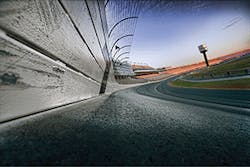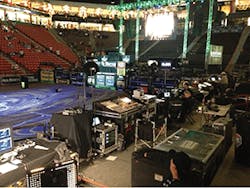The wide use of HD video, emergence of 4K and 8K ultra-high broadcast standards, and increasing popularity in the audio-video sector is placing greater demands of data transmission systems. Fiber optic technology, with its ability to deliver digital, high bandwidth, and low signal-loss streams, provides an ideal solution for coping with those demands.
Figure 1. Indianapolis Motor Speedway (IMS) Productions mobile Unit Group travels the nation in heavy-duty trucks equipped with studios and satellite uplinks that provide live production services for national sports and entertainment broadcasts and events.
However, when it comes to remote broadcasting from harsh conditions, the advanced needs of permanent broadcasting studio infrastructures, and the increasingly popular use of audio-video technology among businesses and government agencies, a new set of demands is being placed on the fiber optic cable industry.
It’s Not Just for Sport
Sporting events are among broadcast’s toughest venues, requiring the rapid pulling of miles of field-deployable fiber optic cable across fences, through water, around rough-hewn rodeo arenas, and along frozen ski slopes or blazing racetracks.
Remote broadcasts demand the brisk deployment of dozens of strands of cable to cameras that fly over football fields, hang from cranes, and are then re-gathered and tossed into crates to be shipped to the next tough venue. Most important, in all of these harsh broadcasting environments, it must survive again and again.
Remote broadcasting specialists, such as IMS Productions, are involved with such rigorous field environments throughout the year. Headquartered across from the famed Indianapolis Motor Speedway, the company’s Mobile Unit Group travels the nation in heavy-duty trucks equipped with studios and satellite uplinks that provide live production services for national sports and entertainment broadcasts and events.
Figure 2. Broadcasting from sporting events like the Indianapolis 500 demands the brisk deployment of dozens of strands of cable which are then re-gathered and tossed into crates to be shipped to the next tough venue.
"Our fleet of mobile studios travels to hundreds of events across the country throughout the year, sometimes having to set up and tear down the same day before heading to the next venue," says Paul Nijak, IMS Productions Director of Engineering. "Even with all the rigors of meeting this schedule, remarkably little fiber cable gets broken — perhaps 1 or 2 pieces a year." (See Figure 2.)
One of the group’s typical weeks includes providing broadcast production for the Verizon IndyCar Series, in locations such as St. Petersburg, where the 1.8-mile, 14-turn circuit incorporates city streets and a section of airport runway where 100,000 ft. of broadcast cable are laid behind temporary walls and fences, flown across sections of track, and sometimes pulled through swamps and waterways. (See Figure 1.)
Immediately following the race, the crew gathers up the cable and heads cross country to a PBR (Professional Bull Riders) Built Ford Tough Series event, where an average of 15,000 ft. of cable is unspooled by hand around a ring where it is exposed to considerable grime and foot traffic. (See Figure 3.)
Figure 3. Broadcasting from remote venues like the Professional Bull Riding (PBR) event in Las Vegas required 15,000 of cable to be unspooled by hand around a ring where it is exposed to considerable grime, foot traffic, rough fences, water, and a wild bull or two.
The cable that this team utilizes for all the field events it covers is deployable broadcast-quality fiber manufactured by Optical Cable Corporation (OCC). The broadcast quality of this fiber cable is high enough to meet the 4K ultra-high-definition broadcasting standard that IMS Productions is currently field testing with Time Warner Cable Sports. (See Figure 4.)
"Our installations range from extremely hot to extremely cold temperatures," Nijak explains. "For example, this year we covered the Alberta Alpine Ski event in Calgary, Canada. At that venue we trenched down into the snow with a chain saw to bury the cable so that groomers could pack snow over the top to help protect the cable. In total, we laid about 50,000 ft. of fiber running all the way up the side of the mountain."
Permanent Broadcast Infrastructures
On the other hand, permanent broadcast fiber installations, such as TV production facilities, require the pulling of cable through a conduit that will stay in place as lasting infrastructures.
Figure 4. The broadcast quality of fiber cable is critical and must be high enough to meet the 4K ultra high-definition broadcasting standard that IMS Productions is currently field testing with Time Warner Cable Sports.
Diversified, a leader in custom media-related solutions, has a deep heritage in broadcast systems. The company provides design and integration services for TV stations, broadcast and cable networks, professional and collegiate sports venues, mobile production units, as well as production and post-production facilities.
Many facilities require unique cable infrastructure, so Diversified has a strong appreciation of the advantages fiber optic cable offers for greater durability and ease of installation. In this case, 6- and 12-strand DX Series indoor/outdoor distribution cables are often a good solution for many challenging installations. (See Figure 5.)
On one project, Guzman’s team had a situation where the cabling in the building needed to be plenum rated. However, the final 200 feet of cable was in an underground conduit that was subject to flood-out. "For our copper cable types we had to run both an underground-rated cable and a plenum-rated cable," Justin Guzman, Project Engineer explains. "Where the conduits emerged from underground we spliced them together. For the fiber, we were able to utilize an indoor/outdoor cable series, which met the criteria for water blocking and plenum rating. This enabled us to forgo a lot of additional fiber splicing and management."
Figure 5. Fiber cable with a rigid central strength member is of vital importance in permanent installations. Fiber cable is pulled through conduit and is often exposed to 10 times the tension it would normally incur.
Business AV Applications
Companies large and small are dependent on using AV applications for critical services ranging from training to teleconferencing. Many of these applications require the integration of a variety of different AV devices within facilities at many geographic points. This often requires staffing installation people with installation skillsets such as crimping and soldering, particularly when various types of AV gear are not configured to work together.
When the companies transition AV facilities from analog to digital, it requires a new type of cabling to carry digital signals. This means a different type of installation technician is needed: IT integrators. These technicians have the tools and skillsets required to install fiber optic cable, to transport packetized data, alongside cable to power the equipment. Performing this type of installation entails pulling both types of cable, cutting it to length, terminating it and then plugging it into AV gear.
However, if this process can be simplified, installation becomes more efficient and less expensive. In some instances, AV users employ hybrid cables that include both the fiber optic and power cable all in one. Ideally, a cabling kit could be used, with each kit containing pre-terminated, pre-cut cabling for connecting specific equipment housed in each of multiple (sometimes hundreds of) AV rooms.
This "kitting" of the plug-and-play cable for specific AV room locations allows standard installation contractors to handle the installation tasks rather than requiring the expertise of IT or AV contractors. This results in a reduction of installation time, as well as saving significant money on labor.
These 3 real-life application stories show that fiber deployment tactics are not one-size-fits all. When the real challenges come into play, the type of fiber cable and the professionals involved can make or break the success of broadcasts across a variety of markets.
Save
Save
Save
Save
Save
Save
Save
Save
Save





